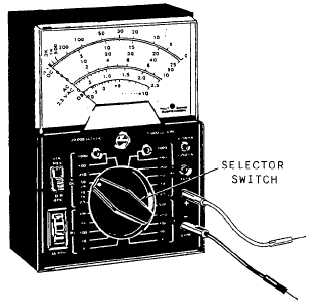secondary winding is checked by connecting the ohmmeter to the coil case and to the high-voltage center tower. Again, an infinite reading indicates an open winding; if any reading is obtained, it indicates a shorted winding. Be sure to use the middle- or high-resistance range of the ohmmeter when you check the continuity of the secondary winding.
5. Check the operation of the ignition pulse amplifier by detaching the positive and negative leads from the coil and connecting them in series to a 12-volt, 2-candlepower bulb.
6. Crank the engine and observe the bulb. If it flickers on and off, the amplifier is operating properly. If the bulb does not flicker on and off, check the distributor.
7. Connect a vacuum source to the distributor and an ohmmeter to the two terminals on the distributor connector. Open the vacuum source to the distributor, and observe the ohmmeter throughout the range of the vacuum source. A reading less than 550 ohms or more than 750 ohms indicates a defective pickup coil in the distribute.
8. Remove one ohmmeter lead from the distributor connector and ground it. Again, open the vacuum source to the distributor as you observe the ohmmeter. A reading less than infinite indicates a defective pickup coil.
ELECTRONIC IGNITION SYSTEM
Provided the engine analyzer is not available, you may troubleshoot the electronic ignition system to prevent unnecessary replacement of its expensive units. (See table 4-1.) You will need a volt/ohmmeter with a 20,000 volt/ohm range. Check the battery in the system being tested; battery voltage must beat least 12 volts.
CAUTION
Make sure the ignition switch is off when the control unit connector is being removed or replaced.
Disconnect the wiring plug from the control unit, and turn on the ignition switch. Ground the negative voltmeter lead. Connect the positive voltmeter lead to the harness cavities designated in the sequence recommended by the manufacturer. Voltage should be within 1 volt of battery voltage with all accessories off. If not, check that circuit through to the battery. Turn the ignition switch off after completing the voltage test. Connect the ohmmeter to the cavities designated. If resistance is not within the manufacturer's range, disconnect the dual lead connector from the distributor. Recheck resistance at the dual lead connector. With one ohmmeter lead still grounded, connect the other lead to either distributor connector. If the ohmmeter shows a reading, replace the distributor pickup coil. To test for control unit continuity, ground one ohmmeter lead and connect the other lead to the control unit pin designated. If continuity cannot be obtained after removing and remounting the control unit in an attempt to get good ground, replace the control unit. Make sure the ignition switch is
OFF, and reconnect the control unit connector plug and the distributor plug. Check the air gap adjustment as described previously. After these tests or repairs, test the entire system by removing the center wire from the distributor cap. Using insulated pliers and a heavy rubber glove, hold this wire about one-half of an inch from the engine block and operate the starter. If there is no spark replace the control unit and retest. If no spark is obtained, replace the coil.
TROUBLESHOOTING LIGHTING SYSTEMS AND ELECTRICAL
ACCESSORIES Most modern automotive and construction vehicles (Military Tactical CESE included) have up to 60 or 70 lights and numerous electrical accessories, such as small motors, gauges, solenoids, and switches. Each one of these devices presents a new troubleshooting problem to the CM1. To perform these tests, you need a few simple hand tools, such as screwdrivers, pliers, a 12/24 volt test lamp, and most important, a volt/ohmmeter (fig. 4-42). For routine testing of burned out light bulbs,

Figure 4-42.-Typical volt/ohmmeter.
Continue Reading